The History of Puma: Everything You Need to Know About the 76-Year-Old Brand

Last year marked the 75th anniversary of Puma, one of the world’s largest sportswear brands and one-half of one of the most interesting sibling rivalries you’ll ever learn about.
The German company has made its impact on the world through soccer, running, basketball, hip-hop, Formula 1 racing, and more over its rich history. Some of the most iconic shoes ever made belong to Puma, and the brand looks to be due for a major 2024 through it’s recent revival of its Rihanna partnership and the Mostro sneaker, as well A$AP Rocky’s new post as creative director for the F1 division.
More from Footwear News
Porsche and Puma Model LaMelo Ball's MB.03 Sneaker After the 911 Turbo
Noah and Puma Team Up on a High-Top Wrestling Boot for Fourth Collaboration
Below, Footwear News takes you through some of the major milestones that have helped shaped the company.
The Dassler Brothers
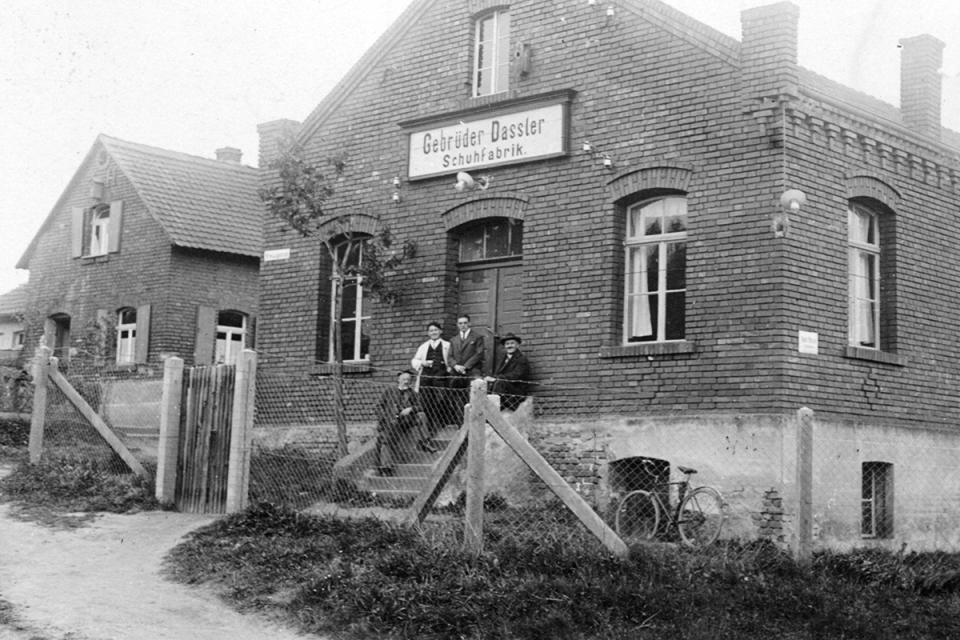
Brothers Rudolf “Rudi” and Adolf “Adi” Dassler formed Gebrüder Dassler Schuhfabrik — “Dassler Brothers Shoe Factory” in English and “Geda” for short — in 1923. Adolf, the younger brother by two years, had spent the previous years developing specialized footwear for specific sports, which had yet to be standard, and repairing in his hometown of Herzogenaurach after World War I.
Once they became a team, Adolf continued to focus on development while Rudolf handled sales and marketing. Demand became high enough in 1926 for the company to move from a converted washroom in their family home to a production space in which a staff of 25 people could produce 100 pairs of shoes per day.
The company’s early focus was on shoes for football (soccer) and running, including the first footwear for the former sport to feature leather studs. German distance runner Lina Radke wore Dassler track spikes while setting a new world record for the women’s 800m race at the 1928 Olympics in Amsterdam, and Geda’s running footwear would rise in popularity throughout the ‘30s. The company’s biggest moment yet would come when its country hosted the 1946 Olympics in Berlin, where Jesse Owens was the most famous of all athletes to sport Dassler spikes.
Further growth saw the brothers open another factory in 1938 with a staff of 118 workers churning out 1,000 pairs of shoes per day. Before World War II broke out and led to restrictions, the company reached a sales height of 200,000 shoes annually.
Birth of Puma and Adidas
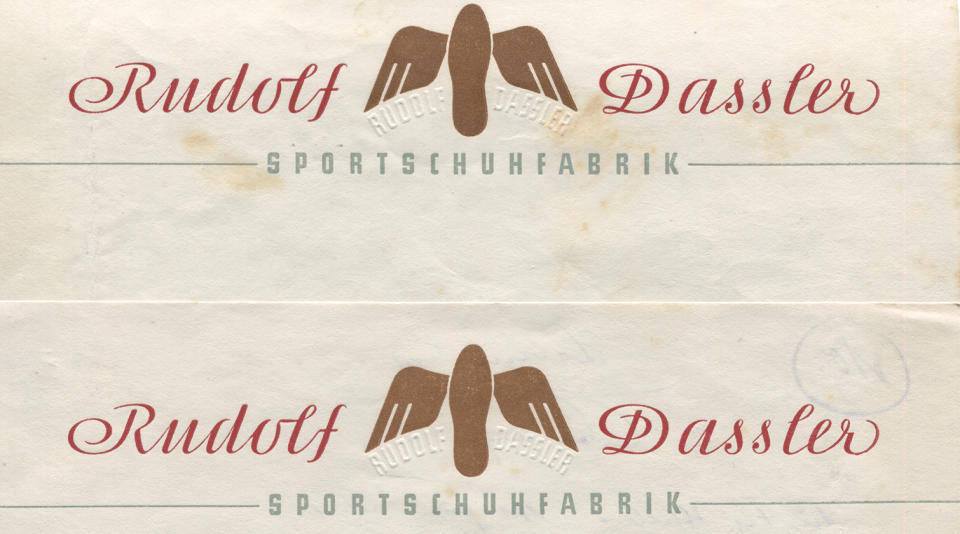
There isn’t a consensus on what exactly caused such a dissolution in the relationship between Rudolf and Adolf that they’d cease doing business together, even amongst their grandchildren living today.
Several of the reputed explanations involve World War II. In one story, Adi and his wife went into a bomb shelter Rudolf and his family were already in during an Allied air attack. Adi said, “The dirty bastards are back again” in reference to the allies, but Rudolf took it to mean him and his family. There are also reports that Adolf suspected Rudolf, who had been conscripted into the military, helped arrange an order that required the Dassler factory to cease footwear production and be redirected to war effort. Conversely, it’s also been said that Rudolf believed Adolf supplied the Allies with information that led to his arrest and incarceration for a year after the end of the war.
Whatever caused the rift between the two brothers, it led Adolf to form Adidas, a portmanteau of Adi Dassler, and Rudolf to form Ruda, another portmanteau, before changing the company name to Puma shortly after. Both companies remained in the Herzogenaurach, where they still are to this day, helping to create a rivalry not just within the family but within the whole town as well.
On Puma’s side of the Aurach River, Rudolf began with 14 employees in 1948. That same year, several members of the West German football team wore Puma boots, and a relationship with coach Sepp Herpberger would lead to the company’s first big hit.
The Super Atom, King and a Football Legacy
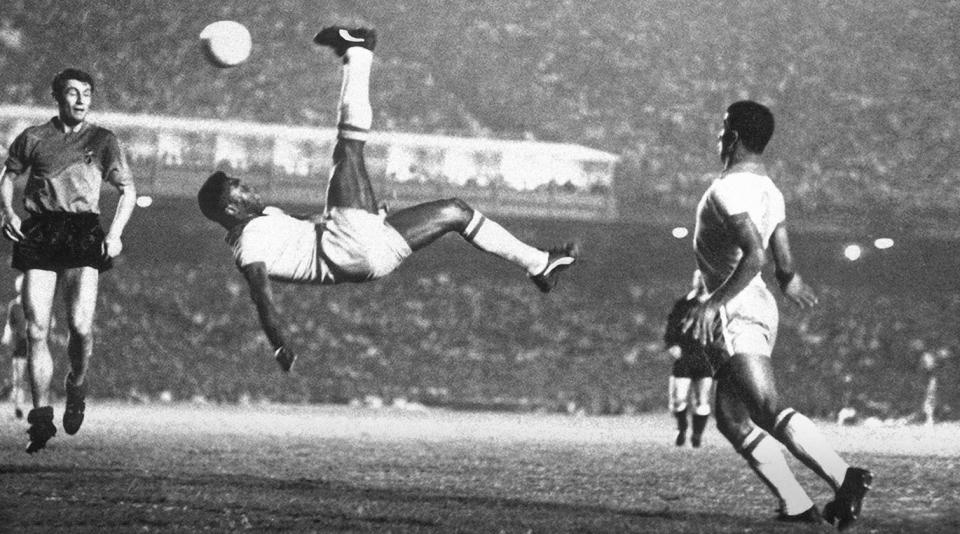
Made in collaboration with Herpberger and as successor to the Atom from 1950, 1952’s Super Atom was the first football boot to feature screw-in studs. Ahead of the Super Atom’s launch, employees gave Rudolf a golden version of the boot that remains on display at company headquarters to this day.
Another legendary football boot would arrive in 1968: the King. Puma originally made the boot for Portuguese legend Eusebio, who at that point was already the top scorer at the 1966 World Cup (where Portugal finished third), the Ballon d’Or winner of 1965 and the European Cup’s top scorer for three years in a row. Eusebio asked Dassler specifically for soft and flexible shoes, so Puma outfitted the King with a new sole construction with plenty of give and non-slip nylon screw studs.
Two years later, Pelé would wear another iteration of the King featuring a flat construction in a bid for lightness, softness and comfort. Pelé bent down to tie his shoelaces at the center of the field just before kick-off of Brazil’s quarter final match against Puma, intentionally leading to a delay in the start and a close-up televised shot of the shoes. The marketing stunt proved massive for Puma and broke the “Pelé Pact” in which both Puma and Adidas had agreed not to sign the icon in order to avoid a bidding war. Pele was paid $120,000, the equivalent of nearly $1 million today, to play his part, and Puma also paid off the cameraman to ensure the shot was captured with zoom.
As Puma continued to update the King, it continued to appear on the feet of some of the game’s greatest players, including Johan Cryuff later in the ‘70s and Diego Maradonna in the ‘80s. Even today, Puma puts out new iterations of the boot — with Neymar serving as the most recent headliner.
Lothar Matthaus also donned the King throughout the ‘80s and ‘90s. Because his father had worked at the Puma factory, he was even hesitant to sign with Bayern Munich, an Adidas-sponsored team, out of concern he wouldn’t be able to continue wearing Puma footwear.
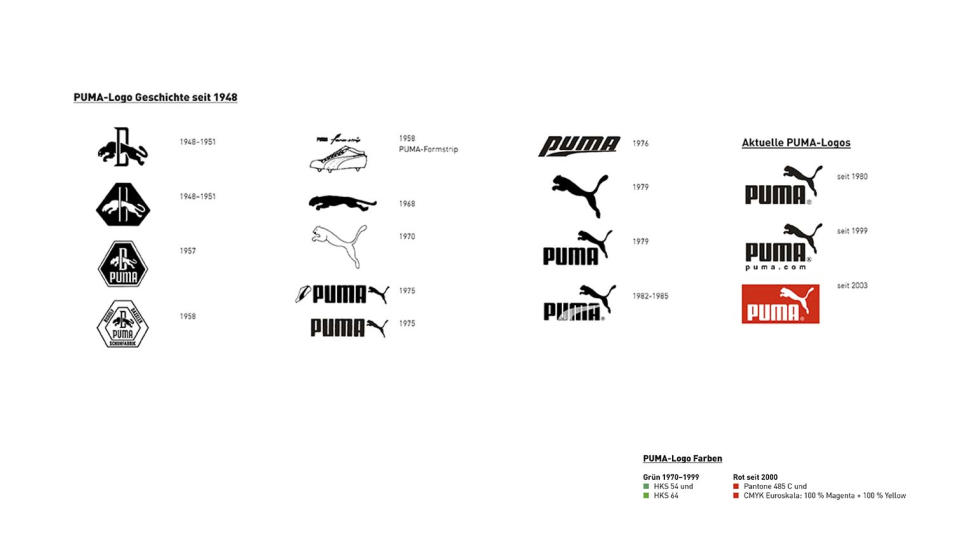
Logos
Necessity in the evolution of football boots led to the creation of the Formstrip, Puma’s primary mark alongside the animal logo and one the company emphasizes is more than mere striping.
Lighter materials were a boon for football boots in the ‘50s but at the sacrifice of stability. The solution: an additional leather strip was added to the lateral side of Puma’s boots in 1958 to help lock in the foot. By appearing in a different color from the rest of the shoe’s upper, the Formstrip also stood out to provide immediately recognizable branding. It also didn’t hurt that the Brazilian national team wore Puma boots while winning their first World Cup that same year, and a testimonial ad for the boots signed by the players after the tournament reinforced the association with greatness.
Puma has also used an animal mark for as long as it’s been in existence, but the mountain lion has essentially appeared in its current leaping form since 1968, with only small tweaks being made since. Officially, the mark is called the “No. 1 Logo.”
The Crack, Clyde and Suede
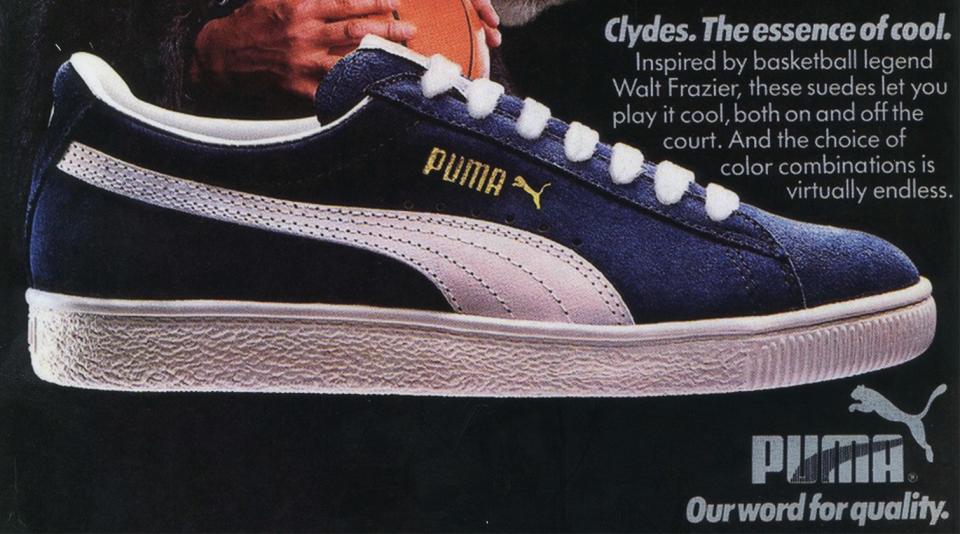
The Clyde and the Suede are one in the same, with the former name giving way to the latter at the end of the ’70s, and its story begins with the Crack.
Puma launched the Crack in 1968 as a lifestyle shoe, a concept that was still novel, leading up to the Olympics in Mexico. Athletes for Puma would wear the shoe during the Games while they weren’t competing, including American runners Tommie Smith and John Carlos, who removed their shoes on the podium before famously raising their leather-gloved fists for one of the most famous protests in history.
NBA great Walt “Clyde” Frazier, whose nickname was derived from the movie “Bonnie and Clyde,” signed with Puma and requested custom low-top basketball sneakers in 1973. He wanted to wear a new colorway for each game, so Puma swapped the Crack’s leather for suede because the latter material is easier to dye. “Clyde” was debossed in gold onto these versions of the sneaker, thereby giving it its new name.
Because Frazier’s contract with Puma only gave it naming rights within the United States and until the end of the ’70s, Puma needed another name outside of the parameters. Naturally, the new “Suede” moniker called out its signature material.
As the Suede, the sneaker was adopted in the ‘80s by the rap, DJ, breakdancing, and graffiti crowd that formed early hip-hop culture. The B-boy crew New York Breakers and rap group Rocksteady Crew both made the sneaker a part of their uniform, much like Run DMC would later with the Adidas Superstar.
Puma now releases both Clydes and Suedes, and you can immediately tell the difference by seeing which name is debossed onto the shoe’s medial. Frazier’s sartorial bonafides also remain well known today, as his flair for suiting is seen on a regular basis in his capacity as the New York Knicks’ color commentator.
Running System (RS) and RS Computer
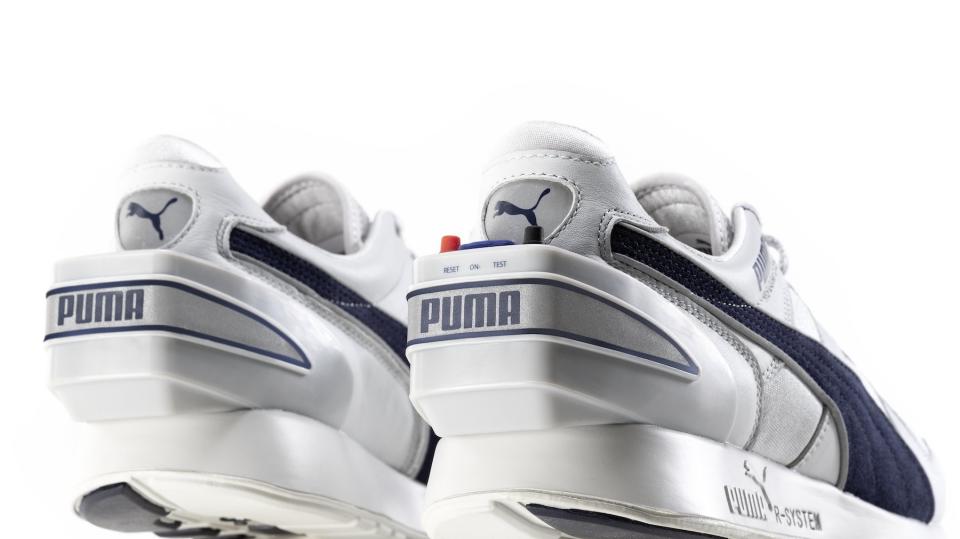
Puma launched its Running System (RS) cushioning technology in 1985 and a year what it claimed as the world’s first computerized sneaker, the RS-100 (later known as the RS Computer).
An on-board chip came conspicuously attached to the heel and recorded data including time, distance, and calories burnt. Users could access that data by plugging their shoe into a computer with a 16-pin connector.
Despite Puma’s claim, ever-pesky Adidas actually released its own smart shoe two years earlier in 1984. The rival Micropacer recorded the same data through a microsensor on the left toe and displayed the information through a screen on the tongue, obviating the need to connect to a computer.
In 2018, Puma would bring back an updated RS-Computer with Bluetooth connectivity to connect to a dedicated Android and iOS app. Only 86 pairs were released worldwide.
Speedcat and Formula 1

Puma first began producing fireproof sneakers exclusively for Formula 1 drivers in 1998 before making the shoe available to the public in 2001 as the Speedcat. In 2005, the brand would become even more entrenched in the sport by entering into a partnership with Scuderia Ferrari that still continues today, making the Puma and Ferrari an inseparable duo in racing gear.
Mostro
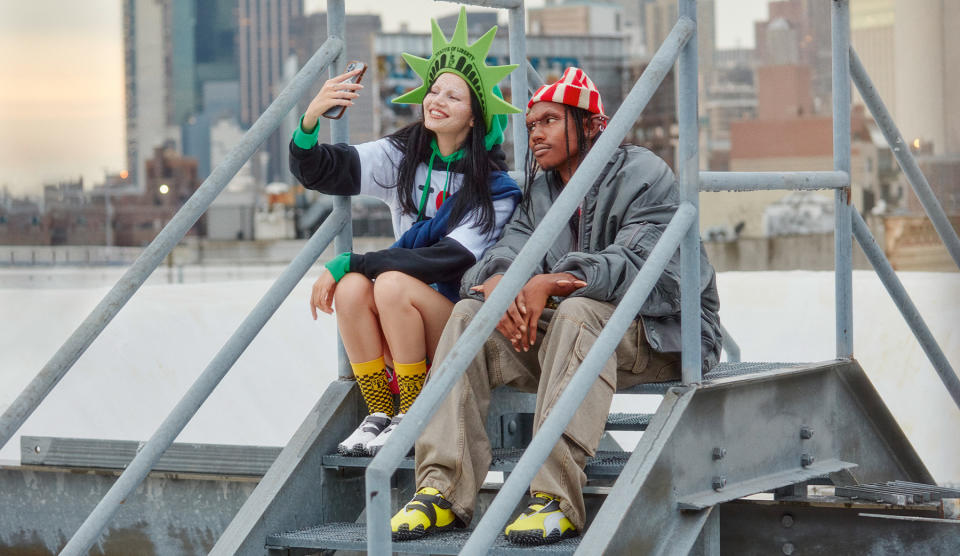
The Mostro, which is now just beginning a major revival push from Puma, made its debut in 1999 and even then was intended as a lifestyle shoe. Boasting a streamlined appearance made futuristic with its spiky midsole climbing over the upper, the sneaker combined the aesthetics of ’80s surfing shoes and ’60s track spikes. It became a major fashion hit in the early-’00s, an association Puma is leaning into once again by hosting a New York Fashion Week party centered upon the Mostro alone.
Serena Williams and Cameroon Uniform Controversies

Puma had a one-two punch of lightning rod uniforms in 2022. The Cameroon women’s national soccer team wore sleeveless kits at the 2002 African Cup of Nations, only for the uniforms to be banned later that year at the World Cup. To conform to the rules while maintaining the dynamic look, Puma simply added mesh sleeves.
Before signing with Nike, Serena Williams wore a black leather catsuit cut short and without sleeves at the 2002 U.S. Open. Criticism of the uniform was rife with the racism that’s followed the Williams sisters throughout their careers, and in 2018 the French Open banned Williams’ full-length catsuit made by Nike.
Rihanna Partnership
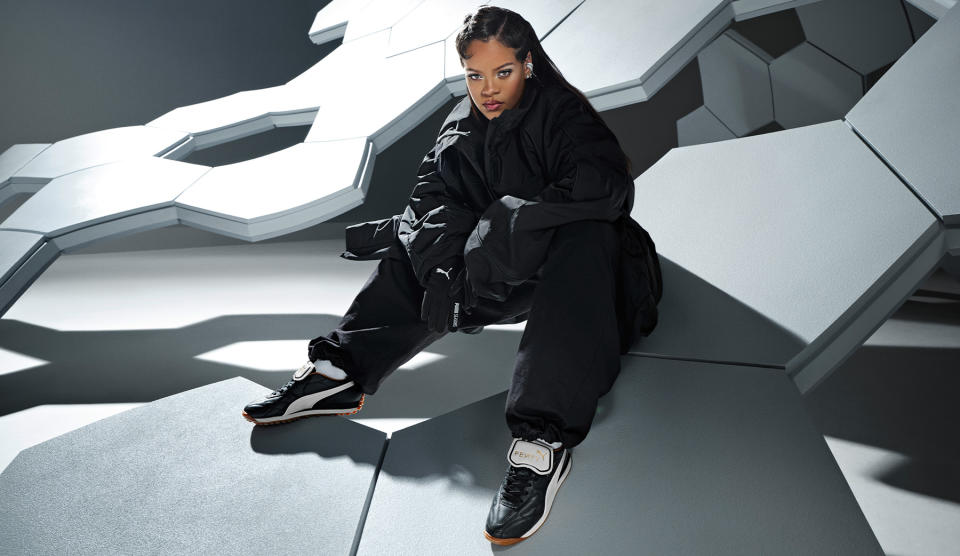
In what has to be the most significant development for Puma of the new millennium, the company announced Rihanna in 2014 as its Women’s creative director and ambassador.
A year later, the wildly successful Fenty Puma Creeper would launch, as the Suede was remixed with a brothel creeper platform crepe sole. It was named Shoe of the Year for the 2016 FN Achievement Awards. In her acceptance speech, Rihanna said she was “proud to be a woman and proud to be a young woman from Barbados, especially to come to America and just do this by default just because I liked to wear a certain style of shoe.”
After a six year hiatus, the two parties reunited last year by launching a new collaboration on the Avanti to capitalize on the soccer trend and adding a puffed-up “Phatty” version of the Fenty Creeper. Shortly after, her husband A$AP Rocky joined Puma as well as the creative director for the brand’s F1 division, a smart choice after the sport has been rising in popularity since the pandemic and the “Drive to Survive” documentary series.
About the Author:
Ian Servantes is a Senior Trending News Editor for Footwear News specializing in sneaker coverage. He’s previously reported on streetwear and sneakers at Input and Highsnobiety after beginning his career on the pop culture beat. He subscribes to the idea that “ball is life” and doesn’t fuss over his kicks getting dirty.
Best of Footwear News
Bape Shoe Collaborations Through the Years: Kanye West, Ronnie Fieg and More
Timberland Collaborations Over The Years: From Vans to Louis Vuitton
Sign up for FN's Newsletter. For the latest news, follow us on Facebook, Twitter, and Instagram.
